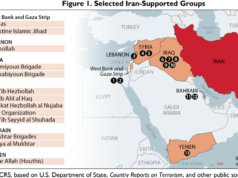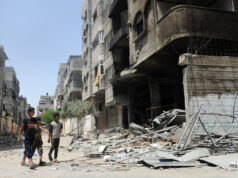Frontpage Interview’s guest today is Jonathan Schanzer, director of policy at the Jewish Policy Center. He has served as a counterterrorism analyst at the U.S. Department of Treasury and as a research fellow at Washington Institute for Near East Policy. He is the author of the new book, Hamas vs. Fatah: The Struggle For Palestine. Daniel Pipes wrote the foreword to the book and some of the research was undertaken at Pipes’ Middle East Forum.
FP: Jonathan Schanzer, thank you for joining us again.
Schanzer: My pleasure, Jamie.
FP: Today, I’d like to talk about the way Hamas has governed Gaza since taking it over by force in 2007. But first, please briefly review the thesis of your new book Hamas vs. Fatah: The Struggle For Palestine.
Schanzer: My new book documents the ongoing political and military struggle between the two largest Palestinian factions – Hamas and Fatah – dating back to 1988. Today, as a civil war rages in the West Bank and Gaza Strip, Israel, the international community cannot even identify a legitimate Palestinian interlocutor. The book looks at how we arrived at this difficult place.
FP: Please tell our readers about the June 2007 war between Hamas and Fatah.
Schanzer: In a word, it was brutal. The battle for Gaza lasted a mere six days. Fatah’s forces, trained and armed by the United States and other western nations, failed miserably. Some left the field of battle. Others joined the Hamas fighters. Those who stood their ground were likely not prepared for their brutal enemy. According to the Palestinian Center for Human Rights, Hamas violence was indiscriminate, demonstrating a willful disregard for the conventions of war. Hamas fighters pushed Fatah members from the roofs of tall buildings. Hamas even killed people who were already injured, or shot their enemies at point-blank range to ensure permanent disabilities. Hamas also attacked private homes and apartment buildings, hospitals, ambulances, and medical crews. All told, the June fighting claimed the lives of at least 161 Palestinians, including 7 children and 11 women. Some 700 Palestinians were wounded.
FP: What happened when the guns fell silent?
Schanzer: Hamas began to govern through a combination of violence, authoritarianism, and Islamism. Ismael Haniyeh, the ascendant ruler of Gaza, officially denied accusations that Hamas intended to establish an Islamic emirate. However, by November, the British press reported that “only believers feel safe” in Gaza and that “un-Islamic” dress sometimes resulted in beatings. According to a UN report, women “felt coerced to cover their heads not out of religious conviction but out of fear.”
The new Hamas government attacked the media and peaceful demonstrations, and engaged in the “destruction, seizure, and robbery of governmental and non-governmental institutions,” according to one human rights report.
In short, the few reluctant steps toward liberalization that the PA had taken during its 13-year rule in Gaza—small advances in press and political freedoms, for example—were wiped out in days.
FP: There were reports of torture. Were these accurate?
Schanzer: Yes. Some 1,000 people, almost all members of Fatah and the PA, were illegally arrested in the first months of Hamas rule by the new Hamas police, the Executive Force. The leader of the Executive Force actually admitted to the use of torture and violence against Hamas’s political enemies. He stated in August that torture occurred in Hamas prisons but that the EF was trying “to minimize violations and avoid them through the training of our members.”
The allegations of torture continued, however. In September, Hamas abducted five Fatah men who were later transferred for treatment to a Gaza hospital, where evidence of torture was reported. Rights groups reported that other Fatah prisoners “sustained fractures to the feet” as a result of beatings with sticks. In other instances, Fatah men were “handcuffed and blindfolded” and had pieces of cloth stuffed in their mouths to stifle their screams.
FP: How did Gaza’s Christian population fare?
Schanzer: They probably suffered the most. Hamas grossly mistreated the minority Christian community, mostly Greek Orthodox, which had lived in relative peace for centuries amid Gaza’s predominantly Sunni Muslim population.
In June 2007, masked gunmen attacked the Rosary Sisters School and the Latin Church in Gaza City. Hamas gunmen used rocket-propelled grenades to storm the main entrances of the school and church. Then they destroyed almost everything inside. That same month, Hamas kidnapped Professor Sana al-Sayegh, a teacher at Palestine University in Gaza City, and forced her to convert to Islam against her will. Her family’s attempts to meet with Hamas leaders to find her repeatedly failed. Requests by community leaders to meet with Hamas were also turned down.
In October, the body of 30-year-old Rami Ayyad, the owner of the Holy Bible Association, was found in an eastern suburb of Gaza City. Ayyad’s organization had been the target of a grenade attack during protests stemming from the cartoons of the Prophet Mohammed that appeared in the Danish newspaper Jyllands-Posten in 2005.
In February 2008, unidentified gunmen blew up the YMCA library in the Gaza Strip. Two guards were kidnapped, offices were looted, and vehicles were stolen, and more than 8,000 books were destroyed. That attack came only days after a Hamas “modesty patrol” attacked a Christian youth’s car after he was seen driving a female classmate to her home. Both were injured in that attack.
By one count, more than 50 attacks had taken place in the first few months following the June coup. Targets included barbershops, music stores, and even a UN school where boys and girls played sports together.
FP: Did the Gaza population fight back?
Schanzer: Some tried non-violent resistance. However, those who held demonstrations against the lack of law in Gaza also suffered. According to al-Jazeera, the Executive Force beat peaceful Fatah demonstrators after the coup. By August, Hamas banned unlicensed demonstrations by the Fatah party. According to Hamas, the demonstrations were “being used to create chaos and terrorism.”
Hamas’s apprehension over the demonstrations was understandable. They sometimes turned violent, particularly when Hamas security forces began forcefully dispersing the crowd. Associated Press television aired images of Hamas men beating an unarmed protester with sticks. In some cases, according to Amnesty International, Hamas deliberately shot unarmed demonstrators. In two cases, Palestinians were shot and killed while trying to help other demonstrators who were injured.
It is interesting to note that when Hamas threw rocks at Israelis during the 1987 and 2000 uprisings, the group called this “resistance.” When Palestinian protestors threw stones at Hamas, the new rulers of Gaza called them “outlaws” and arrested them.
FP: So, why did most people not hear about this in the West?
Schanzer: Hamas worked assiduously to cover its own tracks. To control the reporting out of Gaza, Hamas began to issue government press cards to journalists. Predictably, journalists whom Hamas did not like did not receive credentials. The Palestinian Journalists Syndicate protested that the tactic threatened journalists and prevented them from doing their jobs. The syndicate alleged that under the Hamas government’s draconian rules, phrases such as “Hamas militias” and “ousted government” were banned. Hamas also announced it would ban stories that did not support “national responsibilities” or those that would “cause harm to national unity.”
The more journalists complained, the more difficult Hamas made it for them. The Union of Palestinian Journalists reported that after a series of threats, Hamas forces raided the home of one journalist. The union further noted that its ranks had been threatened and blackmailed by Hamas on a daily basis. The Foreign Press Association confirmed these reports, claiming Hamas had engaged in “harassment of Palestinian journalists in Gaza.” Reporters Without Borders, an international media watchdog group, noted that Hamas “failed to investigate” these incidents.
FP: How did Hamas manage the Gaza economy?
Schanzer: Rather horribly. Due to Israel’s sanctions against the Hamas government, stores in Gaza were out of many products, and hospitals ran low on crucial supplies, including anesthetics and antibiotics. Seeking to avert a humanitarian crisis, the Israelis eventually allowed certain medical supplies into Gaza but vowed to withhold other nonessentials. However, Hamas ensured that goods and supplies would be cut off every time they launched rockets into Israel. Indeed, they had a choice. They could either fire rockets and ensure continued suffering for their people, or cease the violence and make sure the population was provided for. For nearly a year, Hamas chose violence.
Hamas also neglected Gaza’s infrastructure. As a result of Hamas mismanagement, several Gaza sewer pipes burst, which flooded homes and businesses with a foul river of waste that was several yards high. Gazans were infuriated when it was learned that the Israeli-made pipes that were intended to repair Gaza’s decrepit sewage system had been sold to Hamas but used to assemble Qassam missiles and bunkers.
The most anger, however, likely stemmed from the Hamas government’s decision to raise taxes on cigarettes. Lucky Strikes used to cost 10 shekels ($2.50) per pack. After Hamas came to power, the same pack of cigarettes cost 16 or 17 ($4.00 or $4.25) shekels. Other American cigarettes could cost Gazans upward of 40 shekels per pack ($10.00). The Gazans who could not afford to smoke were said to be “fuming.”
FP: Some people say that there were positive aspects of Hamas rule. How is that possible?
Schanzer: Hamas, of course, attempted to highlight the positives. Within weeks of the takeover, the Islamists boasted that crime, tribal clashes, and kidnapping had all dropped precipitously in the Gaza Strip. But, this drop in crime was more than likely the result of fear on the part of Gaza residents rather than a sign of increased or improved law enforcement.
Hamas proved once again that terrorist groups, much like their Fatah predecessors, were unfit to govern. The Islamist group exhibited an almost criminal indifference to the suffering of Gaza citizens impacted by the violence, lack of services, deepening poverty, collateral damage from the battles, and the predictable Israeli reprisals that resulted from Hamas attacks.
FP: Jonathan Schanzer, thank you for joining us.
Schanzer: You’re quite welcome, Jamie. Always a pleasure.
Jamie Glazov is Frontpage Magazine’s managing editor. He holds a Ph.D. in History with a specialty in U.S. and Canadian foreign policy. He edited and wrote the introduction to David Horowitz’s Left Illusions. He is also the co-editor (with David Horowitz) of The Hate America Left and the author of Canadian Policy Toward Khrushchev’s Soviet Union (McGill-Queens University Press, 2002) and 15 Tips on How to be a Good Leftist. To see his previous symposiums, interviews and articles Click Here. Email him at jglazov@rogers.com.





